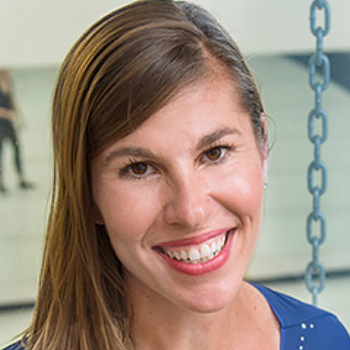Technology may not be the first thing to come to mind when thinking of dancing and choreography, but Marsha Barsky is changing that perception.
“I integrate technology into all of my classes and have found exciting and novel approaches to using computer and video technology for studio classes,” she said.

MTSU Dance Program Director Marsha Barsky poses for a photo in the observation area above one of the dance studios inside Murphy Center. Barsky has incorporated technology into her teaching with a unique video platform that lets her provide detailed feedback on her students’ performances. (MTSU photo by Andy Heidt)
“For example, in the annual senior seminar, I work with my students to create an individualized online dance portfolio that integrates a wide range of applications, including social media, and, most recently, I have integrated cutting-edge technology into my studio-based choreography classes.”
As director of the MTSU dance program, Barsky has taught a variety of classes including all levels of modern dance technique, choreography, dance history, dance studies, dance pedagogy, and the Alexander Technique, a somatic movement practice inspired by the teachings of actor Frederick Matthias Alexander.
Since Barsky’s choreography class is studio-based, most class time is allotted to movement studies and presentations.
Her class adheres to a well-honed method that traces its roots to the early days of choreography, and the intricacy and technical nature of Barsky’s instruction requires students time to absorb it. As a result, Barsky turned to technology for help.
Like any educator, Barsky recognizes the challenges of integrating technology in the classroom and also understands the importance of technology in modern academia. She evaluates which form of technology is most effective and then reevaluates and rethinks her teaching methods on these bases.
“The work that I do happens in a physical space, with the moving body, and as such, my appeal to technology has only been to enhance my teaching,” she said. “The crucial concern for educators is to find an appropriate role in higher education and to tailor it to the task at hand.

MTSU dancers Fernando Ramos Cintron, left, and Amy Huffines perform “Plume” at the 2013 Fall Dance Concert in Tucker Theatre. (File photo courtesy of Martin O’Connor)
“Through appropriate technologies, educators can have the opportunity to remodel their pedagogical approach, and when it’s done well, it’s possible to create a diverse learning environment suited to a host of different students.”
Barsky, who directed the Vanderbilt dance program from 2003 to 2007 and joined the MTSU dance faculty in 2006, recognized that technology could be used to advance what she considers the most vital component for her class—the ability to offer meaningful, constructive feedback.
“It can be difficult to recreate the precise movement at issue for the discussion, and this need for precision––and the time limitations seemed to offer ideal platforms for the integration of media-based technology,” she said.
While researching several dance education journals, Barsky discovered a Web-based video platform called Acclaim, which is a video organizing and discussion website that allows instructors to offer real-time movement, assessment, and feedback in ways similar to the instant replay seen in sports broadcasts.
“Since Acclaim is an online platform that allows for students and professors to embed, record, or upload videos, I was able to capture and then comment upon students’ movement practices in the classroom in real time,” she said.
“At the same time, since this is a video platform, once videos are available, my comments can be directly applied at specific locations in the video. These comments can then be downloaded into an Excel file for further referencing.”
The Acclaim platform allows Barsky to critique specific portions of student work such as recorded choreographic studies. Each comment is clickable, and once clicked, the video will jump to the appropriate moment being discussed. Students can also view and respond to comments from their peers.
“It allows students to closely analyze their work in their own free time and offers them the possibility to make appropriate revisions to their choreographic assignments before the next class,” Barsky said. “Many responded very well and used it as a tool for learning. There can be a steep learning curve for technology like this, but all-in-all, everyone comes to appreciate the ability to record, upload, and receive feedback on their assignments.”
Although she plans to continue using Acclaim to enhance instructional approaches in her classes, Barsky acknowledges that technology can never replace the physical aspect of dance education. Instead, she uses technology as a tool rather than a proxy for the classroom itself.
“Carefully selected technology is enhancing my teaching and has made the teaching and learning process more meaningful to both me and my students,” she said. “I know that there are many other ways to incorporate technology into my teaching, and I am looking forward to experimenting with those unknown terrains.”
You can watch a video of “Moments of Awakening,” a dance performance choreographed by Barsky and performed by members of the MTSU Dance Theatre, above. It also features Barsky’s commentary on the origins of the performance. You can learn more about Barsky at her website.
(originally published in the Summer 2015 edition of Communicator, the MTSU Information Technology Division Newsletter)
— Dan Copp (daniel.copp@mtsu.edu)


COMMENTS ARE OFF THIS POST